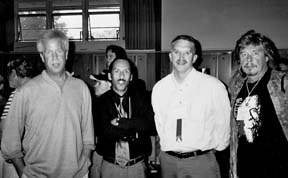
July 22, 2009
In an exclusive exchange with Doug Hajicek, the Executive Producer of MonsterQuest responses to Cryptomundo readers’ recent comments in the wake of the program “Critical Evidence,” which tackled the Sasquatch mystery.
Loren Coleman/Cryptomundo: How do you react to the criticism that your shows need to dwell more on one topic, every week, just as you seemed to begin to be doing on “Critical Evidence”?
Doug Hajicek/MonsterQuest: We would love to spend more time on going deeper on topics, such as the geographic concentrations of sightings tied to rain. But the plain fact is the show would get boring to the average viewer…fast.
LC/CM: Okay, for example, why did you pick the rainfall chart?
DH/MQ: Topics are covered within a show that are intriguing, with anecdotal info where simple science can be applied.
The topic of rain correlation may be old news to many veteran Bigfoot researchers and enthusiasts, but is totally new to the average viewer and the average scientist.

LC/CM: Why all the concentration on the lens size?
DH/MQ: The lens size of Patterson’s lens was significant, as now through photogrammetry and new photogrammetry software, these can be used to accurately measure the creature’s height. The finding was a height that is now higher than previous estimates. That is just one of the revelations in that MonsterQuest episode. The lens size was very important to get a triangulation on the creature.
The study will continue.
LC/CM: What’s your general reply to the skeptics of the program?
DH/MQ: I certainly cannot control the statements by independent scientists and experts, which often go something like, “I have my mind made up…don’t bother me with the facts.”
They won’t look and study evidence the way they should.

Doug Hajicek, left, with Daniel Perez, Jeff Meldrum, and Rick Noll.
DH/MQ [cont.]: Thankfully, we run into some wonderful specialists that will study a piece of evidence with an open mind. People like Bill Munns and others should be commended for their patient painstaking work to simply work our way towards the truth through hard work and creative forensics.
LC/CM: You’ve worked with the Bluff Creek footage several times. Do you see returning to it again?
DH/MQ: Yes, the 1967 Patterson/Gimlin footage still has many aspects to be studied and restudied yet.
LC/CM: How about some who say you should add a “Wow” factor to each show?
DH/MQ: I don’t know that factor [smiling]. When I decide what content to put in a show like this I have many factors to consider. One criterion is: What information can I put in the show to make people take notice and think…the rest will happen naturally.
The many benefits of getting people and young adults to think and wonder “seriously” about mysteries are so great they cannot be measured in my opinion.
LC/CM: What do you think of our readers, pro and con, having something to say about your series, in general?
DH/MQ: I thank all the Cryptomundo readers for watching and commenting on the content of each show.
++++
Just as MonsterQuest is set to screen their new program tonight on feral dog attacks, comes word of a scary story of a dog dragging a baby from its Kentucky home. The Associated Press is reporting that the source of the attack was a family pet, Dakota, a mixed breed with wolves in its ancestry, allegedly a Native American Indian dog that looks similar to a husky. The family’s newborn was found clutched in the jaws of the dog who had carried him from his crib to the heavily wooded backyard.
Four-day-old Alexander James Smith was rushed to the emergency room at University of Kentucky Hospital in Lexington, where he was listed in critical condition Tuesday with two collapsed lungs, a skull fracture, broken ribs and various cuts and bruises.
The incident took place Monday afternoon, July 20, 2009, at Nicholasville, Kentucky.
New on History channel’s MonsterQuest for the evening of Wednesday, July 22, 2009 (check local times):
THE REAL CUJO: Dogs are known as man’s best friend, but now canines are striking fear into many who report attacks by predatory packs. Originally descended from wolves, domesticated dogs were brought to the United States 12,000 years ago and used as aggressive protectors. Today, more and more dogs are being turned loose on the streets and returning to their wild roots. These feral dogs are attacking people. Now, MonsterQuest launches a search to follow these ferals, using state of the art cameras to uncover where they live and how dangerous they are to man.
About Loren Coleman
Loren Coleman is one of the world’s leading cryptozoologists, some say “the” leading living cryptozoologist. Certainly, he is acknowledged as the current living American researcher and writer who has most popularized cryptozoology in the late 20th and early 21st centuries.
Starting his fieldwork and investigations in 1960, after traveling and trekking extensively in pursuit of cryptozoological mysteries, Coleman began writing to share his experiences in 1969. An honorary member of Ivan T. Sanderson’s Society for the Investigation of the Unexplained in the 1970s, Coleman has been bestowed with similar honorary memberships of the North Idaho College Cryptozoology Club in 1983, and in subsequent years, that of the British Columbia Scientific Cryptozoology Club, CryptoSafari International, and other international organizations. He was also a Life Member and Benefactor of the International Society of Cryptozoology (now-defunct).
Loren Coleman’s daily blog, as a member of the Cryptomundo Team, served as an ongoing avenue of communication for the ever-growing body of cryptozoo news from 2005 through 2013. He returned as an infrequent contributor beginning Halloween week of 2015.
Coleman is the founder in 2003, and current director of the International Cryptozoology Museum in Portland, Maine.
Filed under Breaking News, Cryptomundo Exclusive, CryptoZoo News, Media Appearances, Men in Cryptozoology, MonsterQuest, Pop Culture, Public Forum, Reviews, Television